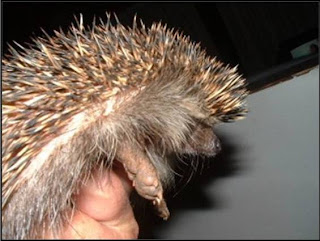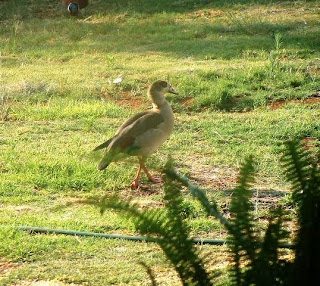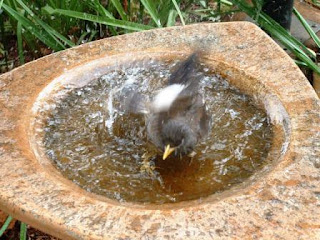Some of my pets, current and past, as well as some garden residents ...
Jacko and I, our Fox terrier x - he's just turned 3 in September '09. Rescued him from a road-side vendor trying to sell him. Selling animals next to the road is illegal in South Africa and should also not be supported, as it creates a market for poachers to catch wild animals to sell at the road-side.

Danny and I - he's still young -about 5 - considering they live to the ripe old age of about 50 or over!

Mai, the Mynah, as a youngster - found her after she had fallen out of her nest. Spent 6 wonderful months with us before she mysteriously disappeared.

Mai, after having a bath

Mai roosting on my MAC speaker

Pippin, my Bush baby. Rescued his as a baby from people throwing stones at him and trying to kill him. Was released back into the wild after he recuperated.

Hedgie, the Hedgehog - spent 8 blissful years with us.

Flutterby, my Laughing Dove, keeping an eye on me whilst in the garden. Saved her from certain death when I rescued her from the Fiscal Shrike who had ideas of spiking her in his pantry.

Duffy, my pigeon, investigating the new nest box. Reared him from a baby straight out of the egg after being abandoned by his parents.

Pappa Goose, with his hobble foot caused by fishing gut cutting off the tendons and nerves - he was found at Florida Lake and brought to me for care and safe-keeping.

Mamma Goose taking a stroll around the garden

My pair of Carolina Ducks (American Wood Duck) investigating their new next box. They're not impressed, because it's supposed to be raised off the ground and they actually turned up their noses and wandered off to inspect one of the other boxes.

Malistic, my Mongolian Ringnek Pheasant saved from certain death when I confiscated him from someone hawking him in the shopping mall as Christmas lunch.

Wynona, Malistic's wife

Black Shouldered kite juvenile with 2 broken wings and a broken coccyx being nursed back to health. Unfortunately he would never fly again.

Kiki and Tweeti, the two Cockatiels, each one with a very different character. Kiki, the grey one, is gentle and soft-hearted, Tweeti very cocky and sure of himself.

Mr. Silky Rooster and his wife - the most gentle chickens ever with the softest, silkiest feathers and unable to fly.

A Mountain tortoise rescued from the pot and released in the Game Reserve.

Chester, our Rottweiler, whose looks belied a totally gentle nature, but who was a fully trained guard dog and followed every command. Unfortunately Chester succumbed after a Puff Adder bit him.

A resident striped field mouse in my garden, recovering from an accidental dosing with the hosepipe!

Two striped field mice snacking on some bird seed in my garden.

The Finches enjoying the bird table.

Mai again, eyeing out the bird bath...

and then deciding to take the plunge.
















































